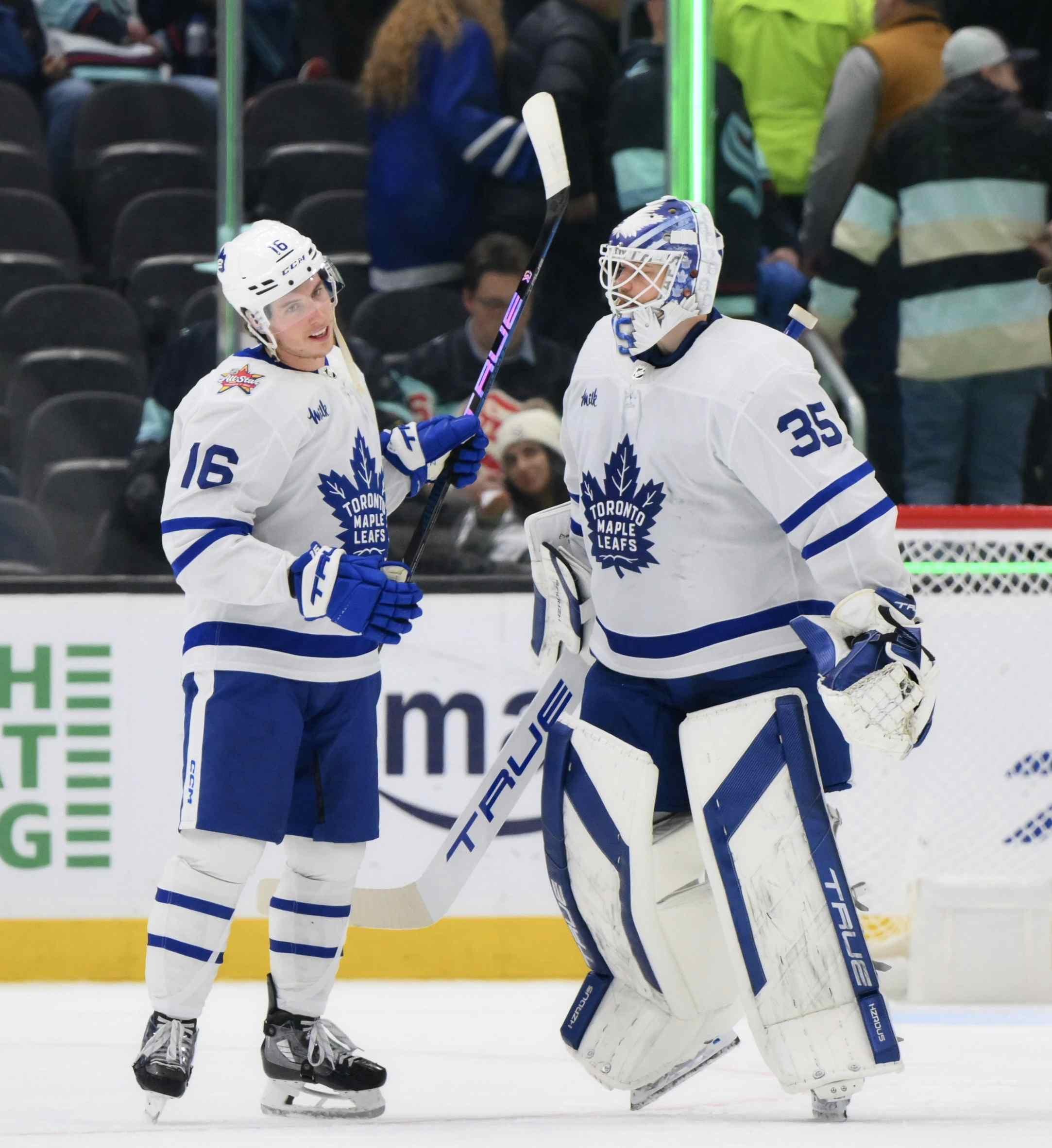TBT: ‘Killer’ Breathes Life into Leafs

While we’ve spent much time talking about the evolution of the Toronto Maple Leafs of late, it’s important to remember that this isn’t the first time the organization has seen a major overhaul. Today, we look back at a previous talent injection into the roster, the acquisition of Doug Gilmour, and how it came to be. Rather than rewording history, though, we’re pulling straight from the archives, thanks to The Toronto Star’s 100 Years in Blue and White: A Century of Hockey In Toronto.
‘Killer’ Breathes Life into Leafs
Gilmour Agrees to Muti-Year Contract
By Rosie DiManno – Published February 1, 1992
When Doug Gilmour stepped onto the ice at the Saddledome on New Year’s Eve, he knew it would be his last game as a Calgary Flame.
As swan songs go, it was a pretty aria. Calgary won that contest against the Montreal Canadiens in overtime. Gilmour counted one goal and one assist.
After it was over, the players celebrated and slapped bums at centre ice. The year was drawing rapidly to a close and there was a feeling in the air, in that joyful and sweaty arena, that the storm of discontent in Calgary had finally broken. It was an illusion.
Gilmour was bear hugged by his teammate, and neighbor, Gary Roberts. “I looked at him right there on the ice and I said, ‘Well buddy, this is my last game tonight.’ He said: ‘I knew sooner or later it would be.’”
A team party followed, with the players and their wives and the bubbly flowing.
“We took a video camera to the party,” recalls Gilmour’s wife, Robyne. “We knew this would be the last time we’d be all together. I started to cry. Doug had this humongous lump in his throat. But I know the whole situation was killing Doug. He just couldn’t take it any more.”
The next morning, Gilmour got to the rink early, packed up his things and walked out on the club.
For an athlete in a team sport, this can be considered the ultimate betrayal—putting self ahead of the rest, the individual ahead of the group.
As he was leaving, Gilmour ran into Doug Risebrough, the intransigent manager of the Flames and the man who had become the enemy. “He said, ‘Doug, if you leave now I’m going to trade you.’ I said, if he could resolve the situation, great. If not, I though it was fair to move on.”
Less than 24 hours later, Doug Gilmour was traded to the Toronto Maple Leafs, the catalyst and featured act in an unprecedented 10-player swap that sent disgruntled Bud Gary Leeman in the opposite direction. “Risebrough called me at home the next day. Said I’d been traded to Toronto. Nothing else, no details. I just said thank you and ‘bye. Then I dropped the phone and ran leaping around the house. If there was any place I wanted to go, it was Toronto.”
A rather masochistic ambition, perhaps.
In truth, Gilmour figures he was on his way to Toronto “about 200 times in the last couple of years.” At one time, when Cliff Fletcher was still calling the shots in Calgary, there were Doug Gilmour-for-Wendel Clark rumbles. When he landed in Toronto this year as grand poobah of all things blue and beautiful, Fletcher set about trying to finagle a deal that would put his former serf Gilmour in a Leaf yoke.
For Gilmour, who had been a key performer in the Flame ascendency of the late ‘80s—including their first Stanley Cup championship in 1989—there was nothing left in Calgary but acrimony and ill will.
The clash with Risebrough, Fletcher’s protégé, is of long standing, says Gilmour’s agent Larry Kelly. “The club had known all last year that there were serious personality problems between Doug and Risebrough.”
But Kelly was not among those urging Gilmour to abandon the club, according to the player’s wife. “His agent kept saying wait, wait. But I knew Doug couldn’t wait much longer. It was obvious just by the way Risebrough would look at Doug on the bench. I could tell he had daggers in his eyes.”
But why the brittle relationship in the first place? The genesis of the rancor is not altogether clear. Gilmour, however, is convinced that he was no longer a key component in the Flames plans for the future and that he was being treated as a marginal player. There was no respect.
“Calgary had six or seven good players but they also had a couple of young guys that they felt could possibly do the same kind of job that I was doing. They wanted another winger that could score and they wanted (Theo) Fleury back at centre. I knew the writing was on the wall.”
So Gilmour wanted to be traded and he believed Risebrough was gratuitously thwarting those plans. Suddenly, it all become personal, very personal.
“Riser and I had been going at it a long time,” says Gilmour. “He wasn’t going to give in to me and I wasn’t going to give in to him. See, I think Risebrough and I are a lot alike. I think we were both kind of pig-headed. We both said some things.…”
The final straw was the arbitration decision last December that went against Gilmour. He had taken the Flames to salary arbitration, asking for $1.2 million (US). The club countered with an offer of $550,000. The arbitrator settled on $750,000.
“I could live with the decision about the money. But I was upset with the whole arbitration process. The way management picked (the arbitrator) up at the airport and sat with him at the game. Then we came in with 200 pages of arguments as far as what we wanted and Calgary came in with three pages.
“It’s obvious that players are not going to get a fair decision in the NHL right now and that has to be changed through the NHL Players Association.”
So, not long afterwards, Gilmour set aside all the principles with which he was raised and abandoned his hockey club.
“Oh, they crucified me in the papers. Man, this was the toughest decision I’ve ever had to make in my lifetime. But I did not leave the team right before a game. There were four open days there to make a trade.
“I didn’t quit.”
Doug Gilmour is sitting in a downtown restaurant, tucking into a plate of pasta and sipping on a beer.
The afternoon hours are an idle time for a professional hockey player, especially one newly transplanted to a still-strange city. He has spent much of his free time looking for a house to rent so he can bring Robyne and six-year-old daughter Maddison to Toronto.
In the meantime, he is living in a hotel. Fortunately, he likes solitude.
There is a vaguely Satanic look to Gilmour, whose face is all dark planes and deep shadows. The eyes are intense and as black as cocoa beans. Around the league, they call him Killer, a moniker that was bestowed upon him years ago by Brian Sutter.
“He thought I looked like Charlie Manson. I don’t know whether it fits or not. Killer is a hard name to live up to. Other players look at me and they see this little guy, 168 pounds, and they think: This is Killer?” He chortles contentedly.
There is much to be content about these days. This week, Gilmour agreed to terms on a multi-year contract with the Leafs that will pay him about $1 million a season.
Since coming to Toronto, Gilmour has given further proof to the general consensus that the Flames were royally bamboozled in The Big Trade. In the process, wing-mate Glenn Anderson has blossomed as well. And don’t look now, but the Leafs are riding a three-game win streak at the moment, thanks largely to Gilmour and Anderson.
“I am just so happy to be here,” says Gilmour, launching into the dutiful language of the working jock. “Glenn and I, we’re still kind of reading each other. I like to drop the puck behind me and he can take the puck to the net hard. He drives to the net. He’s kind of courageous that way.”
This excerpt from 100 Years in Blue and White: A Century of Hockey in Toronto by The Toronto Star is printed with the permission of Triumph Books. For more information and to order a copy, please visit the Star Store.
Recent articles from Jeff Veillette





